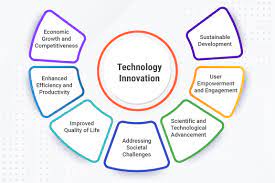The Power of Innovation Strategy
Innovation is the lifeblood of any successful organisation. It is the key to staying competitive in a rapidly evolving market and driving sustainable growth. However, innovation without a clear strategy can often lead to wasted resources and missed opportunities.
What is an Innovation Strategy?
An innovation strategy is a plan that outlines how an organisation will foster creativity, develop new ideas, and bring them to market successfully. It involves setting clear goals, allocating resources effectively, and creating a culture that encourages experimentation and learning.
The Benefits of an Effective Innovation Strategy
Implementing a robust innovation strategy can yield numerous benefits for an organisation:
- Competitive Advantage: By continuously innovating, companies can differentiate themselves from competitors and stay ahead in the market.
- Growth Opportunities: Innovation opens up new avenues for growth, whether through new products, services, or business models.
- Adaptability: A focus on innovation allows organisations to adapt quickly to changing market conditions and customer needs.
- Talent Attraction and Retention: A culture of innovation attracts top talent who are eager to work in an environment that values creativity and forward thinking.
- Customer Satisfaction: Innovative solutions often lead to improved customer experiences and increased satisfaction.
Key Elements of an Effective Innovation Strategy
To develop a successful innovation strategy, organisations should consider the following key elements:
- Clear Objectives: Define specific goals for innovation that align with overall business objectives.
- Culture of Innovation: Foster a work environment that encourages creativity, risk-taking, and continuous learning.
- Resource Allocation: Allocate dedicated resources – both financial and human – to support innovation initiatives.
- Cross-functional Collaboration: Encourage collaboration across different departments to generate diverse perspectives and ideas.
- Risk Management: Implement processes to assess and manage risks associated with innovation projects.
In conclusion, developing an effective innovation strategy is crucial for organisations looking to thrive in today’s fast-paced business landscape. By embracing innovation as a core value and implementing a well-defined strategy, companies can unlock new opportunities for growth, differentiation, and long-term success.
Key Benefits of an Innovation Strategy: Gaining Market Edge, Driving Growth, and Enhancing Customer Satisfaction
- 1. Enhances competitive advantage in the market.
- 2. Drives sustainable growth and expansion opportunities.
- 3. Fosters a culture of creativity and continuous improvement.
- 4. Increases adaptability to changing market trends and customer needs.
- 5. Attracts top talent seeking innovative work environments.
- 6. Leads to improved customer satisfaction through innovative solutions.
The Challenges of Innovation Strategy: Navigating Risks, Resources, and Resistance
- Risk of failure
- Resource-intensive
- Resistance to change
- Lack of focus
- Competitive pressure
- Over-reliance on technology
1. Enhances competitive advantage in the market.
Incorporating an effective innovation strategy can significantly enhance a company’s competitive advantage in the market. By continuously developing and introducing innovative products, services, or processes, organisations can differentiate themselves from competitors and establish a unique position that resonates with customers. This strategic approach not only helps companies stay ahead of the curve but also reinforces their relevance and attractiveness in a crowded marketplace, ultimately leading to sustained growth and success.
2. Drives sustainable growth and expansion opportunities.
One of the key benefits of implementing an innovation strategy is that it drives sustainable growth and expansion opportunities for organisations. By continuously fostering creativity and developing new ideas, companies can not only stay competitive in their current market but also explore new avenues for growth. Innovation opens doors to untapped markets, allows for the development of new products or services, and creates opportunities for expansion into different sectors or regions. This proactive approach to innovation not only ensures the long-term viability of the organisation but also paves the way for sustainable growth and success in the future.
3. Fosters a culture of creativity and continuous improvement.
Fostering a culture of creativity and continuous improvement is a significant advantage of implementing an innovation strategy within an organisation. By encouraging employees to think outside the box, explore new ideas, and take calculated risks, innovation strategy creates an environment where creativity thrives. This culture of innovation not only leads to the development of novel solutions and products but also promotes a mindset of continuous learning and improvement across all levels of the company. Employees feel empowered to challenge the status quo, experiment with different approaches, and contribute to a dynamic workplace where innovation is celebrated and encouraged.
4. Increases adaptability to changing market trends and customer needs.
One significant benefit of implementing an innovation strategy is that it enhances an organisation’s adaptability to shifting market trends and evolving customer needs. By fostering a culture of innovation and continuously exploring new ideas and solutions, companies can swiftly respond to changes in the market landscape and meet the dynamic demands of their customers. This adaptability not only helps businesses stay relevant and competitive but also positions them to proactively anticipate and address emerging trends, ensuring long-term success in a rapidly evolving business environment.
5. Attracts top talent seeking innovative work environments.
An effective innovation strategy has the significant advantage of attracting top talent who are actively seeking dynamic and innovative work environments. By fostering a culture that values creativity, experimentation, and forward thinking, organisations can appeal to skilled professionals who are eager to contribute their expertise in an environment that encourages bold ideas and continuous improvement. This pro of innovation strategy not only helps in recruiting top talent but also contributes to retaining employees who thrive in an atmosphere that nurtures innovation and offers opportunities for personal and professional growth.
6. Leads to improved customer satisfaction through innovative solutions.
One of the key advantages of implementing an effective innovation strategy is that it leads to improved customer satisfaction through the introduction of innovative solutions. By continuously seeking out new ways to address customer needs and preferences, organisations can deliver products and services that exceed expectations, enhancing the overall customer experience. This focus on innovation not only strengthens customer loyalty but also positions the company as a market leader committed to meeting and surpassing customer demands.
Risk of failure
One significant drawback of innovation strategy is the risk of failure. Despite careful planning and execution, innovation projects do not always deliver the expected outcomes, resulting in a loss of resources. This can be demotivating for teams and costly for organisations, especially when investments in research, development, and implementation do not translate into successful innovations. Managing the risk of failure is a critical aspect of any innovation strategy, requiring organisations to be agile in adapting to setbacks and learning from unsuccessful ventures to improve future innovation efforts.
Resource-intensive
Implementing an innovation strategy can be resource-intensive, demanding substantial investments in terms of time, money, and manpower. Allocating the necessary resources for research, development, and implementation of innovative ideas can strain a company’s budget and workforce. The need for specialised skills and expertise in new technologies further adds to the costs associated with innovation initiatives. Balancing the investment in innovation with other operational needs poses a challenge for organisations aiming to drive growth through creativity and advancement.
Resistance to change
Resistance to change is a significant con associated with innovation strategy. When employees or stakeholders are hesitant to embrace new ideas and ways of working, it can impede the innovation process. This resistance often stems from fear of the unknown, concerns about job security, or simply a reluctance to step out of familiar routines. Overcoming this resistance requires effective communication, transparency, and a supportive organisational culture that encourages open dialogue and addresses concerns proactively. Failure to address resistance to change can lead to missed opportunities for growth and limit the potential impact of innovative initiatives within the organisation.
Lack of focus
Lack of focus is a significant con of an innovation strategy. When organisations fail to establish clear objectives and priorities, their innovation efforts can easily become scattered and ineffective. Without a defined direction, resources may be wasted on projects that do not align with the overall goals of the company, leading to missed opportunities and diminished returns on investment. A lack of focus can also result in confusion among team members, hindering collaboration and impeding progress towards meaningful innovation outcomes. It is essential for organisations to set clear goals and priorities to ensure that their innovation initiatives are purposeful, targeted, and ultimately successful.
Competitive pressure
In fast-paced industries, the competitive pressure to keep up with rivals’ constant stream of innovations can present a significant challenge for organisations. The need to stay ahead or at least on par with competitors’ advancements can strain resources, both in terms of financial investment and human capital. This relentless pursuit of innovation to match or surpass industry benchmarks can create a sense of urgency that may lead to rushed decisions or overextension, potentially compromising the quality and sustainability of the innovation efforts.
Over-reliance on technology
An inherent con of innovation strategy is the risk of over-reliance on technology, where organisations may become overly fixated on technological advancements to drive innovation. This singular focus on technology could potentially overshadow critical aspects of business development, such as customer engagement, market research, and operational efficiency. Neglecting these essential elements in favour of solely pursuing technological solutions may lead to a disconnect with customer needs and market trends, ultimately hindering overall business growth and sustainability. It is vital for organisations to strike a balance between leveraging technological innovation and addressing broader business strategies to ensure holistic and effective development.






